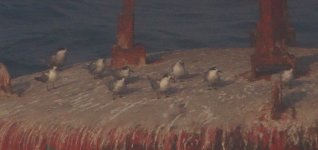opisska
rabid twitcher

From the Farasan ferry.
In this area, most of terns were Lesser Crested, with some Greater Crested, Whiskered, White-winged, Gull-billed, Caspian, Saunder's and possibly Little (and one lone Brown Noddy, incidentally sitting on the other end of this very buoy) - but this group is the one singular set of terns that looks like neither of the above. White-cheeked perhaps? Unfortunately it's not possible to be outside on the ferry, so photos are affected by the windows.
Thanks!
In this area, most of terns were Lesser Crested, with some Greater Crested, Whiskered, White-winged, Gull-billed, Caspian, Saunder's and possibly Little (and one lone Brown Noddy, incidentally sitting on the other end of this very buoy) - but this group is the one singular set of terns that looks like neither of the above. White-cheeked perhaps? Unfortunately it's not possible to be outside on the ferry, so photos are affected by the windows.
Thanks!






